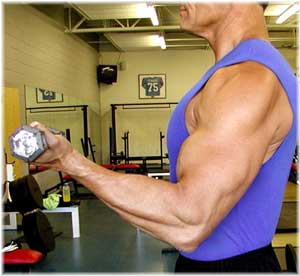Outstanding and
accurate health articles from AFTA partner and author Phil Campbell.
www.weight-loss-pill-diet-nutrition.com/hgh-1.htm
www.dyna-lean.com/hgh-1.htm
www.weight-loss-pill-diet-nutrition.com/dyna-1.htm
Isolation
Key weight
training principle
There are three
key principles in weight training that will multiply your results.
The prinicples are; Isolation, Exhaustion, and
Aerobic Tempo. During this newsletter, we'll look at the
principle of Isolation.
Isolate the Muscle Being Worked
Isolation of
the muscle being worked makes you focus and "zone in" on
the targeted muscle. This helps to define the goal of the weight
training exercise, and it leads to better results.
The Isolation
principle means to isolate only one targeted muscle
group at a time, and consciously leave the other muscle groups
out of the exercise. The tough part of this principle is to
position the exercise to minimize other muscle groups from
assisting the targeted muscle.
Other muscle
groups try to step in and help as the targeted muscle becomes
fatigued, especially at the end of a set. If you allow other
muscles to assist, the impact of training is decreased.
This is the
most difficult aspect of weight training technique. You should
focus on not allowing other muscles to assist when the
targeted muscle gets tired
Correct
Positioning Isolates Muscles
Countless
times, I have talked with individuals, even serious bodybuilders
and professional athletes, who cannot seem to build their biceps.
This is an easy fix.
Invariably,
bicep curls were being performed with the wrists bent "in" toward
the body - rather than straight. Bending the wrists toward the
body positions the forearms to do much of the work, rather than
the biceps.
The Isolation principle means that you should slightly bend the
wrist backwards during curls (away from the body) as shown
below. This prevents the forearms from assisting, thereby
isolating the biceps to do the work. And the biceps receive
the full benefit of the exercise.
The following photos show the incorrect and correct wrist
positions to isolate your biceps
Incorrect - wrist bent in.
Bicep not isolated,
forearm is doing too
much of the work.

 Correct
- the
wrist is slightly bent back, or away from the body. The isolation
is on the bicep, and not the forearm.
Correct
- the
wrist is slightly bent back, or away from the body. The isolation
is on the bicep, and not the forearm.
“Slow Movement”
Weight Training?
Slow movement
weight training is a new trend in some gyms. The idea is to lift
weights very slowly. This method will assist in isolating the
muscle group being worked. However, there is no scientific magic
behind “slow movement” lifting.
If you are correctly isolating muscle groups during training (and
keeping muscle groups isolated during the set), then a
moderate tempo works well.
The Take Home
Whether it's
your biceps, chest, calves, or abs, isolate the targeted
muscle group and you'll get better results.
Have a great
day!
Phil Campbell,
Author Ready, Set, GO! Synergy Fitness for Time-Crunched Adults
Synergy
Fitness makes a big deal about target training
fast-twitch and slow-twitch muscle, why?
To reap the full benefits of Synergy Fitness
training,
it's necessary to understand how your muscle fiber --
slow,
fast, and super-fast
-- are developed
You have three
types of muscle fiber that make up your "muscles," and this is
sometimes called muscle composition.
This is important
because it's the fitness training that targets the super
fast-twitch muscle that makes your body produce the most
powerful body fat reducing, muscle toning, fitness hormone in your
body - HGH growth hormone.
Muscle
Fiber Types
The average
person has approximately 60 percent fast muscle fibers and 40
percent slow-twitch fiber (type I).
The fast-twitch
muscle actually has two types of fiber -- fast and super-fast.
The fast muscle
(what the researchers call IIa) moves 5 times faster than the slow
muscle -- and the super-fast (IIx) moves 10 times faster than the
slow muscle fibers. And there can be swings in fiber composition, (Muscle,
Genes, and Athletic Performance, September 2000, Scientific
American, Jesper).
The following chart shows that while there are differences in muscle
fiber composition, muscle types can be developed based on the way
they are trained.
Muscle Fiber Composition
|
Muscle
fiber
type |
Average
person |
Sprint
trained |
Aerobic
trained
|
|
Slow
(type I) |
40% |
40% |
55% |
|
Fast
(IIa) |
50% |
20% |
40% |
|
Super-fast
(IIx) |
10% |
40% |
5% |
Sprinters have a
higher percentage of the super-fast (IIx). Endurance trained
individuals have more slow muscle fiber (type I). While we are born
with slightly different muscle composition, the point is; super-fast
muscle can be developed if exercised properly.
Why is this important?
Researchers show
that anaerobic exercise (short, quick-burst, gets you out-of-breath
fast exercise) is the type of fitness training that increases HGH
growth hormone. And HGH is, without question, the most powerful
anti-aging, and anti-middle-aging, body fat-reducing, muscle-toning
agent known.
Yet, when we
finish high school (perhaps with the exception of a few that compete
in college and the small number that make it to the pros), we become
slow-twitch exercisers at age 20. And this is a mistake!
Many may continue
developing slow-twitch muscle (less than half of your muscles) with
weight training and cardio at the gym, and with jogging. If you
think about it, we start the muscle atrophy process (the wasting
away of muscle) on half of our muscle fiber ... AT AGE 20!
No wonder we have
an obesity epidemic and this year, 650,000 Americans will hear their
physician say, "you have diabetes."
The cure for the
national obesity crisis, the cure for the middle-age somatopause,
the cure for insulin resistance and (in many cases) diabetes, and
the cure for the high cost of healthcare--is so simple, that we keep
missing it.
The cure is
natural. It's free. But it can't be done overnight because the
muscle fiber needed to perform high-intensity anaerobic exercise has
atrophied (wasted away).
There's great
news?
You can build
back your fast-twitch muscle fiber (slowly at first) by performing
plyometrics to build the fast muscle (IIa) and performing sprinting
types of training to build the super-fast (IIx) to the point where
you can release HGH growth hormone through fitness training.
The
Take Home
You may need to
be doing more than working your slow muscle fiber with weights,
cardio, and jogging. But don't neglect slow-muscle because this is
40% of your muscle fiber, and to a degree, it serves as a base for
the development of the fast and super-fast muscle fiber.
Have a great
day!
Phil Campbell,
Author Ready, Set, GO! Synergy Fitness for Time-Crunched Adults
High-intensity exercise
reduces the risk of heart disease
The
American Heart Association, in a recent news release, cited research
showing high-intensity exercise can significantly lower the risk of
heart disease.
Simply,
as exercise intensity goes up, the risk of heart disease goes down.
New research
The
researchers compared the impact of different levels of exercise
intensity. The study subjects (men average age 66) in the
high-intensity exercise group produced a 31% risk reduction for
heart disease. And this was 14% better than those who performed
"less intense" exercise.
"The
harder one exercises ... the lower the risk of heart disease," said
lead researcher Dr. I-Min Lee, associate professor Harvard Medical
School.
Relative
Intensity
This
study also proves another important point concerning fitness
training during aging. Exercise intensity is relative to one's
fitness level.
In
other words, an older individual can reach high-intensity exercise
with effort that might be considered low-intensity for someone young
and fit.
What does this
mean to you?
Personal
trainer, triathlete, or just starting a fitness program, the goal of
the Ready, Set, Go program is to help you discover the benefits of
releasing your "fitness hormone" through high-intensity
exercise.
This new
study confirms the need for higher intensities, but it also shows
that beginners and older adults can reach the more productive levels
of exercise intensity with less effort than a triathlete, for
example.
The
Sprint 8 Workout described in Chapter 8, Accelerating HGH Release
with Anaerobics may be performed by power walking or by actual
sprinting - running, swimming, cycling, skiing - depending on your
age, current fitness level, and training experience.
Newcomers to high-intensity exercise may get great results initially
by performing the Sprint 8 Workout with power walking.
A fine
tuned triathlete however, may need to add an additional 4 X 150
meter sprints (on run days) and 4 X 50 meter swim
sprints (on pool days) to their Sprint 8 Workout to reach the
desired high-intensity level.
The proper
perspective of fitness training during aging
When you
see an eighty year old participant running a 10-K or working out in
the gym, don't think that it's unfortunate that she can't run as
fast, or lift as much as her younger counterparts.
It's the
intensity of exercise that produces results. And exercise intensity
is relative to current fitness status.
A goal
worth considering
Ever
thought about hiking the Appalachian Trail, running a marathon, or
climbing Everest? But you know you don't have the time.
Here's a very realistic goal worth considering.
If
you're over 50 and not participating in masters and senior
games events, check out these programs;
www.seniorolympics.com,
State Games listings &
www.masterstrack.com
If
you're over 30, training for a master's competition can be
very motivating. And it's certainly a middle-age somatopause buster!
Ages
brackets; age 30-34, 35-39, 40-44, continue on up in five year
increments. Some Masters Web sites are listed below in the MORE INFO
section.
The Take Home
* If
you're not exercising regularly now, this research shows that you
don't have to workout for hours to get results. Get physician
clearance, and get started.
* If
you're a pro and want to help others improve fitness, it's important
to remember that newcomers may get great results initially from what
you might consider a warm-up.
* If you're an X-jock, maybe you can't run a 4.4 any more, but I
think you'll be amazed at how the body responds to a slow,
progressive, wise, buildup program to high-intensity fitness
training.
Phil
Campbell, M.S., M.A., FACHE
Author Ready, Set, GO!
Synergy Fitness for Time-Crunched Adults
www.weight-loss-pill-diet-nutrition.com
www.dyna-lean.com